Content
Published:
This is an archived release.
One in three women will live to 90
If the mortality rate in 2014 reaches the same level in the future, 35 per cent of girls and 22 per cent of boys being born now will reach 90 years of age.
| Year | |||||
|---|---|---|---|---|---|
| 1976 | 1986 | 1996 | 2006 | 2014 | |
| Deaths, total | |||||
| Females | 18 291 | 20 098 | 21 754 | 21 625 | 20 688 |
| Males | 21 925 | 23 462 | 22 106 | 19 628 | 19 706 |
| Deaths under 1 year of age | |||||
| Girls | 256 | 184 | 105 | 74 | 64 |
| Boys | 305 | 224 | 141 | 111 | 80 |
| Life expectancy at birth | |||||
| Females | 78,42 | 79,74 | 81,07 | 82,66 | 84.10 |
| Males | 72,12 | 72,87 | 75,37 | 78,12 | 80.03 |
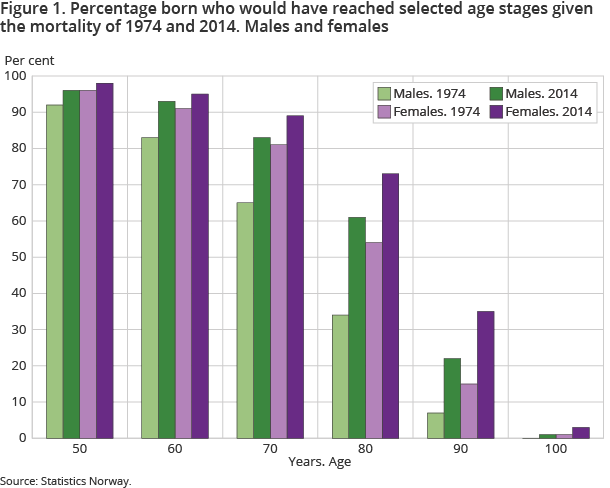
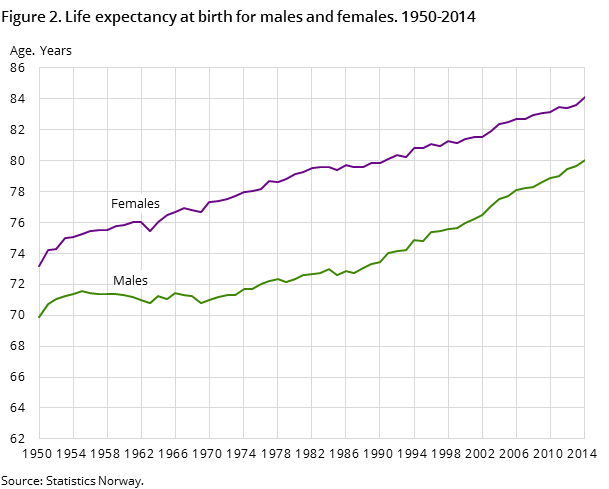
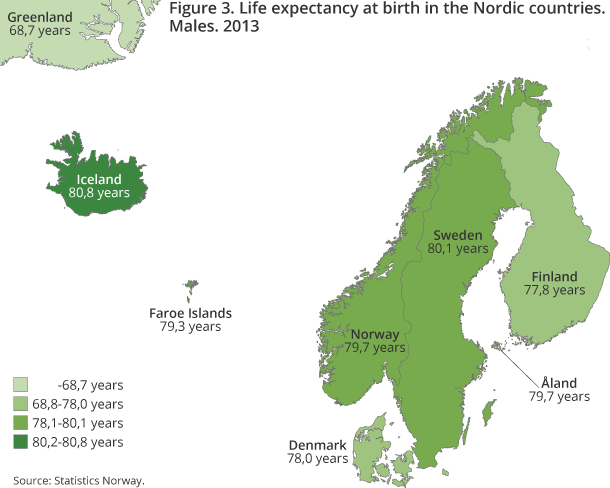
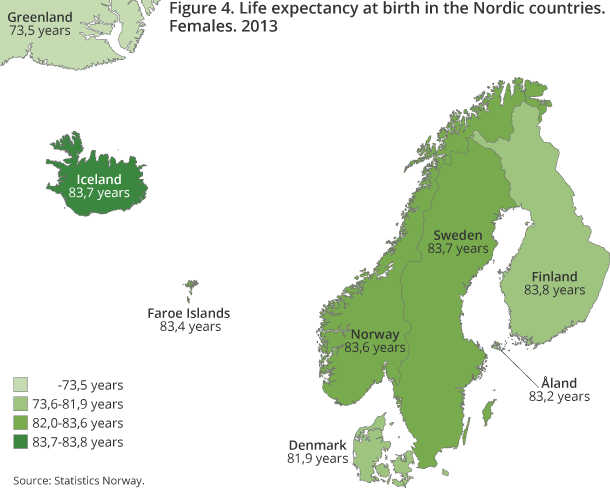
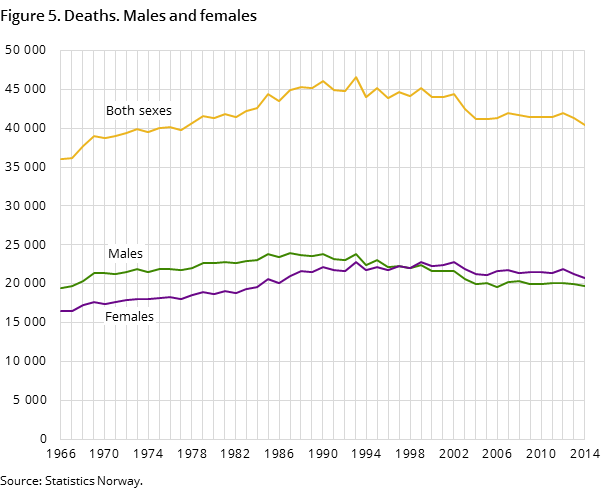
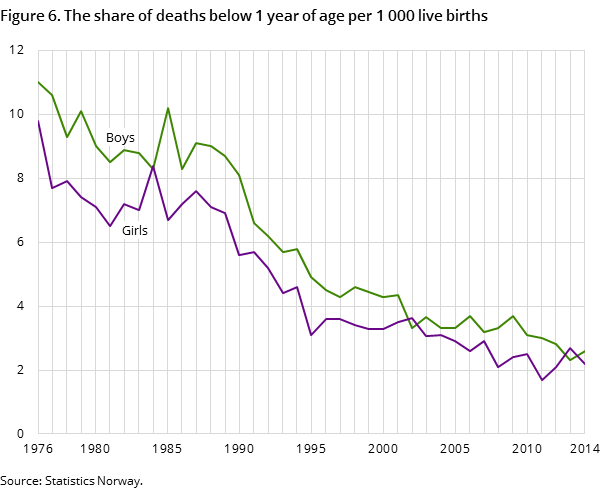
If the present mortality rate continues, 73 per cent of girls and 61 per cent of boys may live to see their 80th birthday. The mortality rate in Norway has been steadily decreasing for a very long time. For example, only 54 per cent of girls and 34 per cent of boys could expect to live to 80 in 1974 according to the mortality rate at that time. Despite the falling mortality rates, however, there are still very few people who live to see their 100th birthday; only 2.7 per cent of girls and 0.9 per cent of boys.
From 2013 to 2014, life expectancy at the time of birth increased by 0.5 years for women and 0.4 years for men. Baby girls and boys can now expect to live to 84.1 and 80.0 years of age respectively. The gender gap in life expectancy in 2014 was 4.1 years in favour of women. For more than a hundred years the gender gap was between 2.5 and 3.5 years, but the gap increased from the mid-1950s to 1980. In the first half of the 1980s the life expectancy gender gap was about 6.8 years. Since then, the gap has decreased gradually to the current level.
Interpretation of numbers
Neither life expectancy at birth nor the share that reach a certain age level are an indication of how long a baby will actually live. These dimensions are estimated under the assumption that the mortality rate in 2014 will stay at the same level in the future, which is not realistic. The mortality rate has been decreasing for many years, and life expectancy at birth and the share that will reach certain ages have increased over the years. If this trend continues, a child born in 2015 will be older than the estimated age that was calculated based on the mortality rate in 2014.
Life expectancy at birth indicates the average number of years that a baby can expect to live under the presumption that the age-specific mortality probabilities will stay constant in the future. Life expectancy at birth and the age level that half of the babies will reach is not the same. The latter is nearly 3 years higher for men and about 2 years higher for women.
Japan continues to have the highest life expectancy
In 2013, women in Japan continued to have the highest life expectancy at birth on a worldwide basis, with 86.6 years. Among the Nordic countries, life expectancy for women in 2013 was roughly at the same level. Denmark was slightly lower with 81.9 years, while Norway, Iceland, Sweden and Finland were slightly higher with between 83.6 and 83.8 years, with Finland at the top. Life expectancy for men varies between the countries. Iceland is at the top with 80.8 years, while Finland, which has the highest life expectancy for women in the Nordic countries, has the lowest for men, with only 77.8 years.
Lowest number of deaths in 37 years
In 2014, 40 400 persons died in Norway; 20 700 women and 19 700 men. This is almost 600 fewer women and 300 fewer men than the year before. This was the lowest number of deaths since 1977, when Norway had one million fewer inhabitants. In relation to the population size, the number of deaths in 1977 was 0.99 per cent, compared to 0.79 per cent in 2014. This is the lowest figure ever registered in our annual registrations, which date all the way back to 1735. One reason for this may be that the small cohorts from the interwar period are now in the oldest age group in Norway. Another reason might be that there was no major outbreak of seasonal influenza in 2014, which would otherwise have affected vulnerable groups. The number of deaths per 1 000 of mean population was 7.6 for men and 8.1 for women, which is a lower mortality rate than the year before in Norway.
Infant mortality remains low
A total of 144 children below one year of age died in 2014; 80 boys and 64 girls. The infant mortality rate is still low, and is now 2.4 children per 1 000 live births. For boys, the rate was 2.6, which is a slight increase from 2013, and for girls it was 2.2 - a slight decrease from 2013. There may, however, be some random factors from one year to another. Norway has one of the lowest infant mortality rates in Europe.
Contact
-
Anders Sønstebø
E-mail: anders.sonstebo@ssb.no
tel.: (+47) 46 66 37 74
-
Magnus Haug
E-mail: magnus.haug@ssb.no
tel.: (+47) 40 81 14 91
-
Ane Margrete Tømmerås
E-mail: ane.tommeras@ssb.no
tel.: (+47) 91 99 29 62
-
Statistics Norway's Information Centre
E-mail: informasjon@ssb.no
tel.: (+47) 21 09 46 42
-
Oppdrag befolkningsstatistikk
E-mail: befolkning@ssb.no
